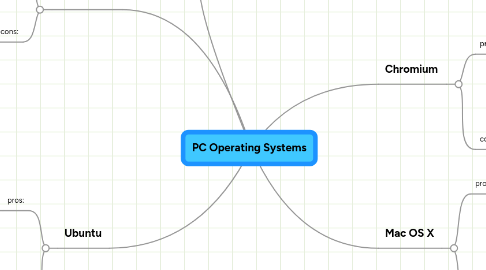
1. Windows 7
1.1. pros:
1.1.1. Most popular operating system
1.1.2. Applications & driver support
1.1.3. Easy to use
1.2. cons:
1.2.1. Not free, restricted, no freedom
1.2.2. Not very stable
1.2.3. Doesn’t come pre installed with good applications
1.2.4. Because of the high usage, most spywares and viruses are targeted to this platform.
2. Ubuntu
2.1. pros:
2.1.1. ready to capitalize on that in ways that the average consumer won’t recognize until he or she finds him or herself using Ubuntu on a MID, a netbook, a kiosk, a phone, a virtualized OS, or a smartbook
2.1.2. Both the regular Ubuntu and the netbook remix benefit from how smoothly Linux runs even on very low-spec netbooks.
2.1.3. Running regular Ubuntu gives you the benefits of taking one of the most popular versions of Linux with you in full desktop form, while running the netbook remix alters the menu structure for higher visibility and adjusts the user experience for comfort.
2.2. cons:
2.2.1. There are no guarantees
2.2.2. There’s no “Works with Linux” logo that buyers can look for when buying new hardware
3. Operating Systems definition
3.1. to organize and control hardware and software so that the device it lives in behaves in a flexible but predictable way.
4. Chromium
4.1. pros:
4.1.1. It proved itself to be the most secure browser in the Pwn2Own contest
4.1.2. Chrome 5 introduces a host of new features including Windows 7 Taskbar Tabs and an intelligent form filler.
4.1.3. Google also unveiled its new ANGLE (Almost Native Graphics Layer Engine) project, which will enhance Chrome’s graphics rendering capabilities across platforms.
4.2. cons:
4.2.1. Chrome, which also uses a modern WebKit engine, matched Apple at 100/100 but unusually produced an error stating that the "linktest failed."
5. Mac OS X
5.1. pros:
5.1.1. Excellent user interface and usability
5.1.2. Stable & Secure
5.1.3. Applications
5.1.4. Easy installation of applications
5.1.5. Targeted less by viruses & spywares
5.2. cons:
5.2.1. The Operating system is limited to a specific platform
5.2.2. Though, based on open source operating systems, it is still proprietary.
5.2.3. Cost of ownership is high
